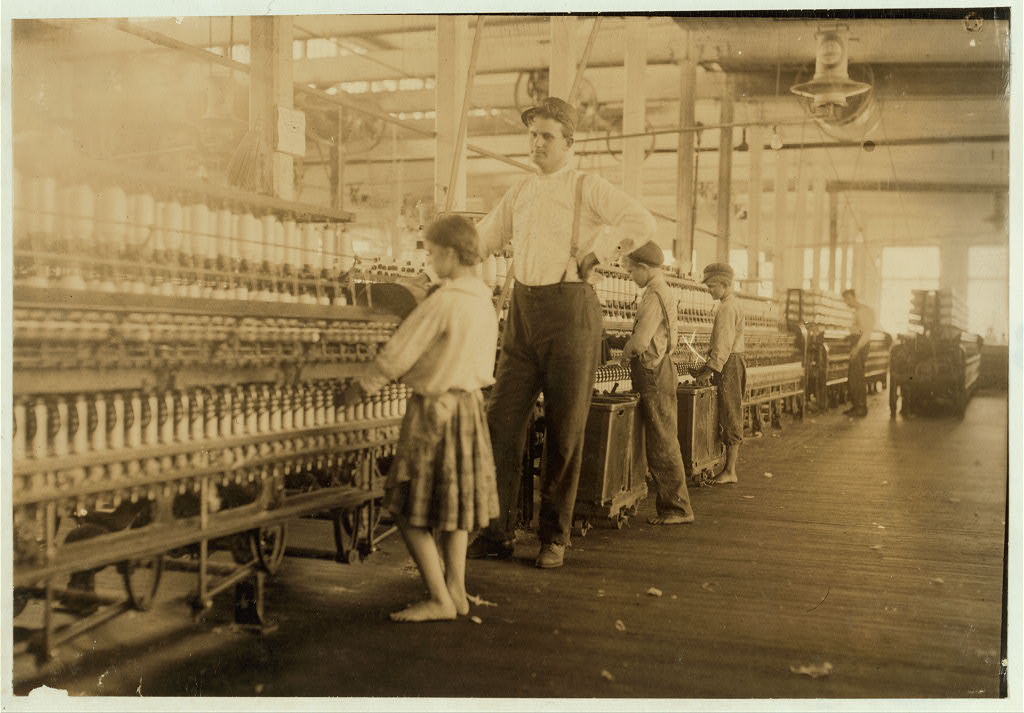Elizabeth Dillenburg highlights continuities between past and present debates on child labor in the United States
Faced with an acute labor shortage, US states and employers recently pushed for younger workers to be hired. These recent debates echo themes that emerged in discussions about child labor throughout the nineteenth and twentieth centuries.

Hine, Lewis, photographer. “[Overseer supervising a girl (about 13 years old) operating a bobbin-winding machine in the Yazoo City Yarn Mills, Mississippi.]” Photograph. 1911. From Library of Congress: National Child Labor Committee collection, Library of Congress, Prints and Photographs Division (LC-DIG-nclc-02093). https://www.loc.gov/item/2018675170/. Accessed July 22, 2022.
Historical Reflections on Contemporary Child Labor Debates in the US
Two years into the COVID-19 pandemic, we are still grappling to understand its far-reaching impact on young people’s lives. The pandemic has upended childhoods, as children have struggled with illness and the death of family members and lost valuable opportunities for socialization and education. In addition to its tremendous psychological, emotional, and physical toll, the pandemic has also reshaped children’s involvement in the economy. Children have been forced to carry a greater share of their family’s financial burden and work in high-risk jobs, especially in the early months of the pandemic when many parents were left unemployed.
When the economy began to reopen in late 2020 and 2021, workers were either unable to return to work due to caring responsibilities and the effects of COVID-19 or hesitant to do so because of poor working conditions and low wages. Faced with an acute labor shortage, governments and employers eschewed tackling the systemic causes of the crisis by providing workers with higher wages, better working conditions, and greater childcare support. They instead turned to hiring younger workers.
In Wisconsin, for instance, the state legislature passed a bill that expanded the hours people under the age of sixteen could work. The state’s governor, Tony Evers, ultimately vetoed the bill, but this action was met with criticism by, among others, the bill’s author, Mary Felzkowsksi, who expounded: “Not only would this bill have gone a long ways [sic] towards assisting many of the small businesses throughout the state, but it would have opened up more opportunities for these teens. Extending the potential hours of work for these young employees would have given them a greater head start in earning money for the future, and a better chance to develop a strong work ethic.”
These recent debates echo themes that emerged in discussions about child labor throughout the nineteenth and twentieth centuries. Children have long been regarded a source of cheap labor, and the development of child labor regulations has often been marked by a tension between economic interests and children’s best interests. While child labor laws were passed in England and Germany in the 1830s and in France in the 1840s, it would take another century for the US to enact regulations on a national level. When the US finally did pass the first federal child labor law, it was due in part to concerted efforts by organizations like the National Child Labor Committee (NCLC).
The NCLC and other reformers argued that childhood should be devoted to play and education, not work, and children needed to be protected from exploitation. In doing so, they helped enshrine elements that define childhood today, and the endurance of these ideas is reflected in contemporary debates on child labor.Stephanie Bloomingdale, president of the Wisconsin AFL-CIO, explained her opposition to the recent bill by asserting that “the priority for young teens must remain their education. Wisconsin kids deserve adequate time to study, to sleep and to imagine the road ahead of them.”
To bolster their case, the NCLC utilized the medium of photography. Lewis Hine’s iconic images of children in mines, factories, mills, and agricultural fields raised greater awareness of the hardships and dangers faced by young workers. Yet it was not enough to end child labor. Instead, the US Congress needed to target companies’ bottom lines, which it effected through the Keating-Owen Child Labor Act of 1916. The Act restricted the interstate commerce of goods produced by factories and mines that employed children under fourteen and sixteen respectively and limited the hours children could work. However, the victory was short lived. Two years later, the Supreme Court declared the Act unconstitutional, stating that it violated states’ rights to control trade.
It took another twenty years and the passage of the Fair Labor Standards Act in 1938 for the federal government to regulate youth employment more effectively. The context of its passage is of course important. The Great Depression and large number of unemployed adults meant that children were no longer as valuable to the economy and thus expendable. The protracted efforts to pass federal child labor laws in the US illustrate how economics often takes precedence in the struggle between what is best for the economy and what is best for the child.
In debates about child labor legislation, we see the negotiation of different ideas of childhood. The development of laws like the Keating-Owen Act and Fair Labor Standards Act centered around key questions about the nature of childhood: How does one define a child? Does childhood end at fourteen years old? At sixteen? At eighteen? What rights do children have, and how can they be protected? What role does the state have in safeguarding children’s welfare? Recent debates in Wisconsin and other states over loosening restrictions on child labor show that the answers to such questions remain deeply contested.
References
“Governor Vetoes Bill for Small Businesses.” Website for the Office of Rep. Amy Loudenbeck -31st Assembly District. February 4, 2022. https://legis.wisconsin.gov/assembly/31/loudenbeck/news/press-releases/governor-vetoes-bill-for-small-businesses/.
“Gov. Evers Stops Roll Back of Wisconsin Child Labor Law.” Wisconsin State AFL-CIO. February 4, 2022. https://wisaflcio.org/news/gov-evers-stops-roll-back-wisconsin-child-labor-law.
“Keating-Owen Child Labor Act (1916).” National Archives. Accessed July 14, 2022. https://www.archives.gov/milestone-documents/keating-owen-child-labor-act.
“The Fair Labor Standards Act Of 1938, As Amended.” U.S. Department of Labor. Accessed July 14, 2022. https://www.dol.gov/sites/dolgov/files/WHD/legacy/files/FairLaborStandAct.pdf.